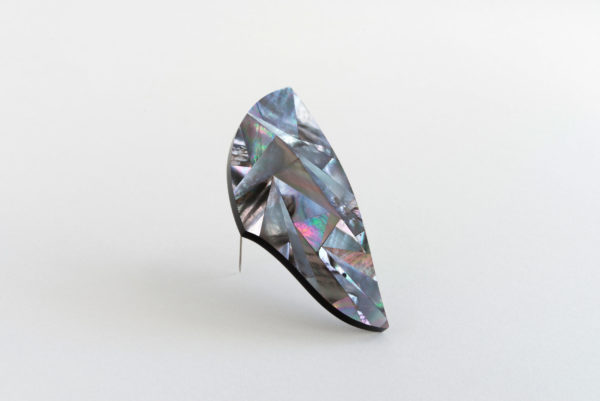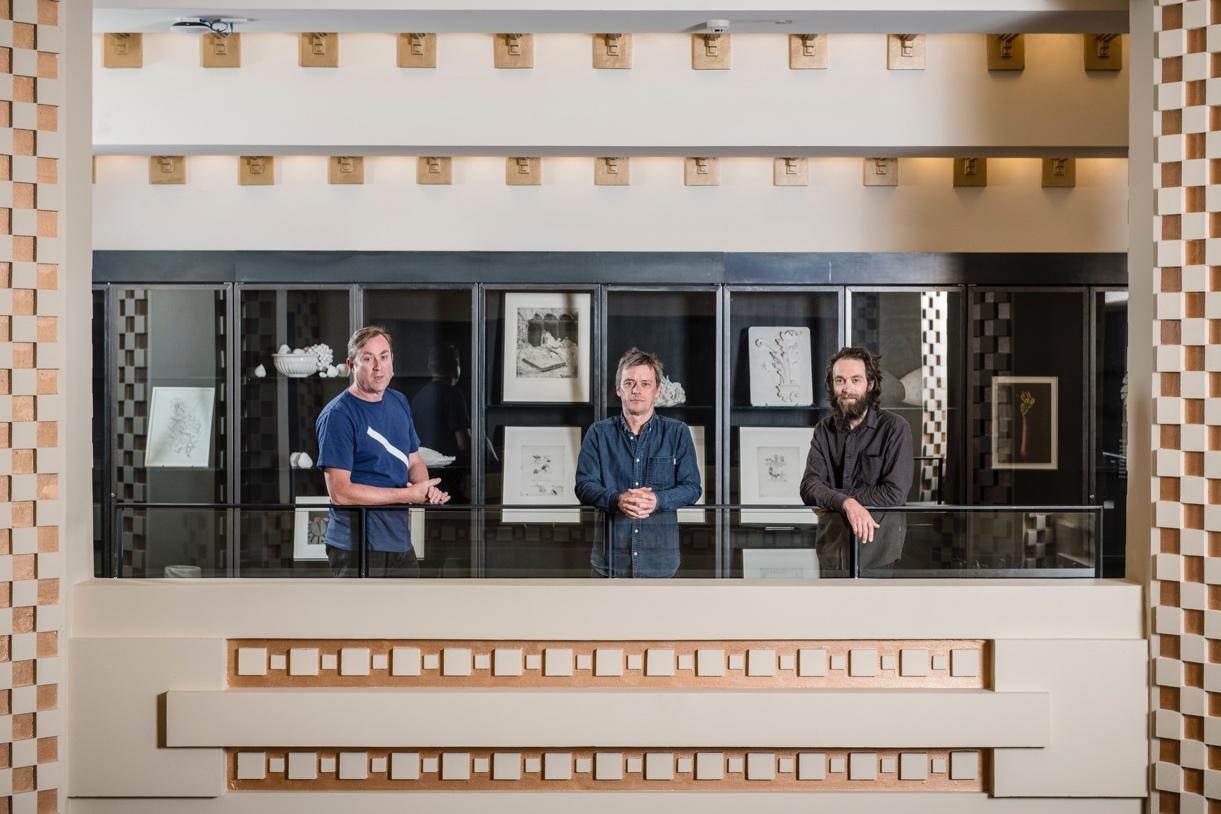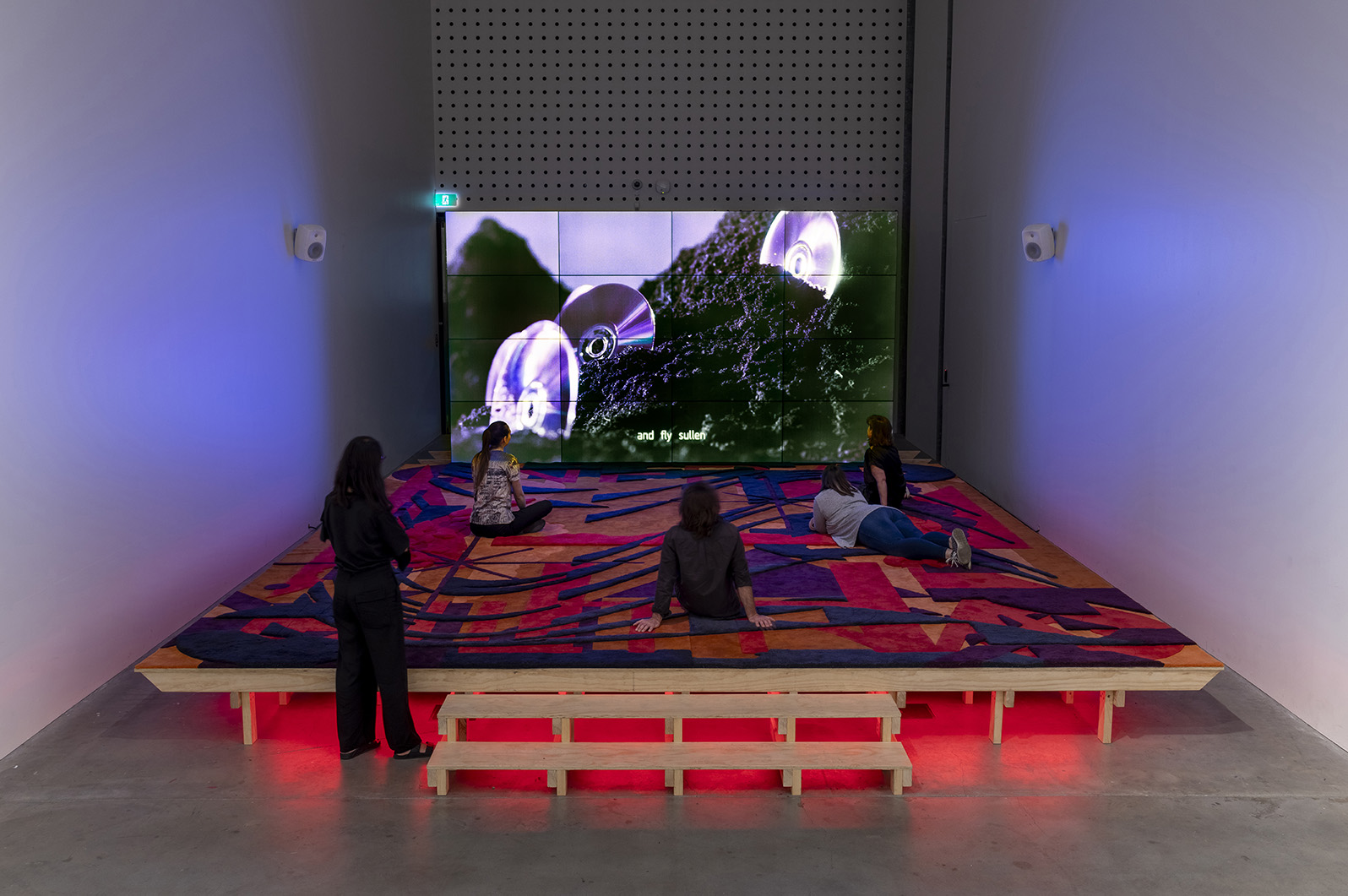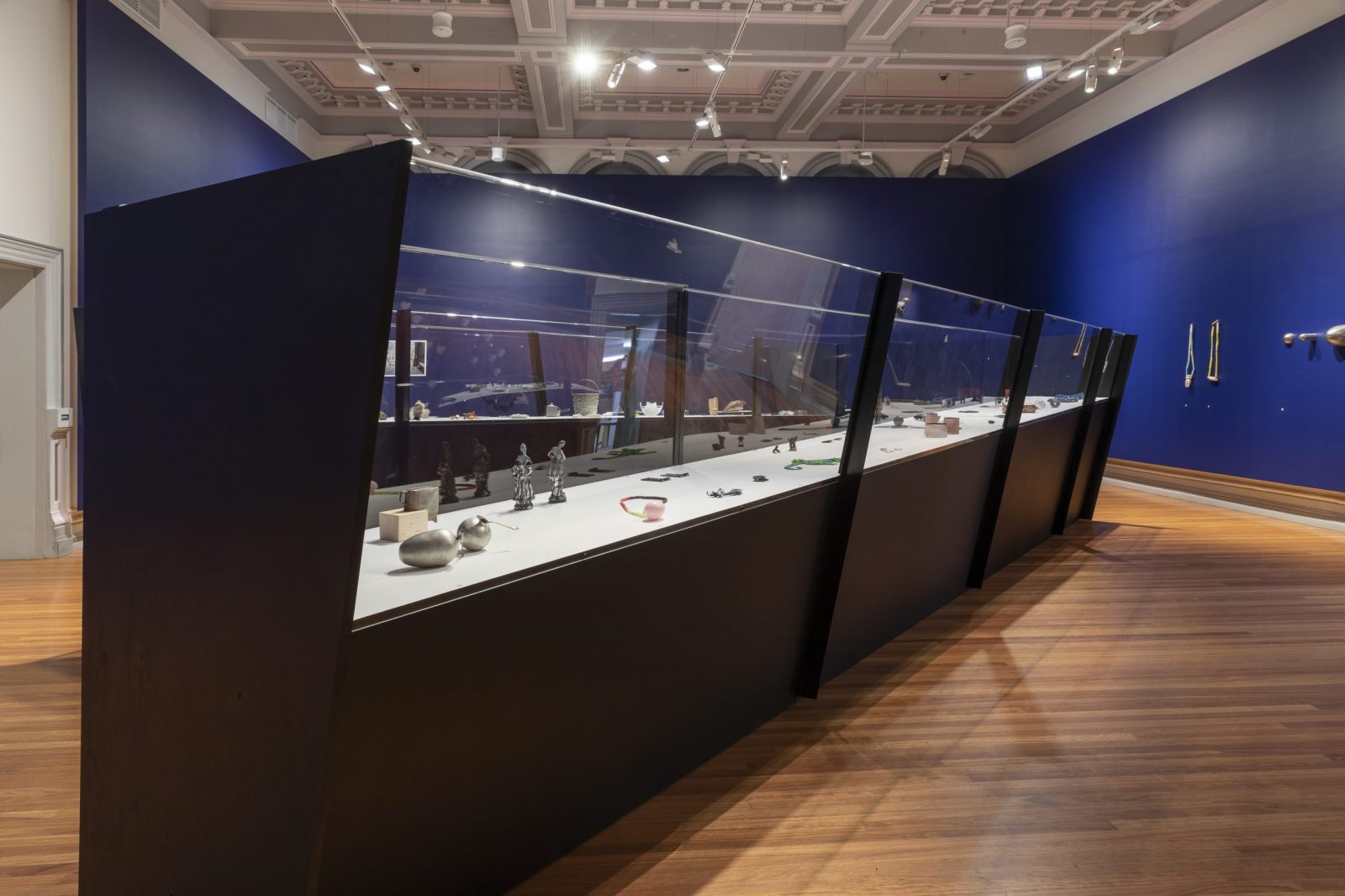
MasterMakers: Digital Catalogue
MasterMakers (6 September—9 November, 2019) Exhibition Catalogue For over two decades, leading Australian and international Gold and Silversmithing artists have delivered and…

RMIT Bachelor of Communication (Public Relations) student Kate Tranter speaks to the team responsible for developing and producing creative projects within RMIT Culture.
1. Who is in the RMIT Production Team?
In the main picture are (from left) the production team’s Erik North, Nick Devlin and Tim Mcleod, in front of The Cabinet of Curiosities a temporary exhibition they installed at The Capitol in 2019. Photo by Eugene Hyland.
Erik North is an exhibition design and production professional with a career spanning over 30 years in the Visual Arts, Culture and Tertiary Education sectors. As Production Coordinator for the Public Engagement Group (RMIT Culture) Erik’s role is primarily collaborative in the production of exhibitions, events and other engagement experiences across RMIT’s exhibition spaces.
Nick Devlin has been in his current role as Production Coordinator at RMIT University since 2017. He completed post graduate studies in fine art at the Victorian College of the Arts and continues to maintain a visual arts practice. Nick has over 20 years’ experience as an Installation Technician working at the majority of Melbourne’s premier art spaces, institutions and festivals.
Tim McLeod completed a Diploma of Arts (Furniture Design) at RMIT University. After 16 years working in the designer/maker and fabrication field, working on a number of projects with artists, architects and designers and on his own solo and group shows, he now applies this knowledge at RMIT as part of the Production Team.
2. What does the RMIT Production Team do?
Nick: The Production Team develops and produces creative projects within RMIT Culture. This mainly involves creating exhibitions of art and design within the many cultural spaces of RMIT but extends itself to installing collection works in and around RMITs many campuses, involvement in audio visual projects and some Academic assessments. The variety of challenges are always different, the work is always interesting, and it is rewarding to see visions and concepts come to life. It is also great to work with our talented and creative teams.
Erik: We present curators, exhibition contributors and designers production methods and opportunities that add value to their ideas. We do this by working with curatorial and design teams, developing, resolving and ultimately “making” the exhibit or event.
The production teams stay involved right from start to finish, working with curators, artists and designers to resolve details and outcomes throughout, sometimes a really important change might collaboratively evolve right at the end of the installation process, hours before opening to the public. It’s a long process, with many contributors and that’s where it gets interesting. Everyone involved has something to offer a project, the collaborative process, when everyone is buying in to the end result, is very satisfying.
2. What role does production play in how exhibitions are perceived by the public?
Erik: The audience is front of mind throughout the production process. We work closely with the designers and curators to realise an event or exhibition always with the audience in everyone’s mind. There are very pragmatic considerations to make also. Making sure accessibility for all members of the public is catered for.

Tim: Integrating the public program requirements into the build plays a huge role in how it is received by an audience. This is generally where the ‘live’ element unfolds in front of a captive audience – you don’t want to waste the opportunity of testing and risking the new ideas together. Also, we will and should be called out if we produce a space that uses toxic materials or do not fully know the ‘waste fate’ of the materials used.
3. How has exhibition production changed over time?
Nick: In the world of exhibitions everything changes regularly. From the materials we use to the waste we try to avoid creating to the spatial design of an exhibition – they all play a huge role in how the audience responds. Content has changed a lot over the years as there is less emphasis on traditional exhibition formats, for example just 2D pictures on the wall. Technology plays a huge part in this and you need to keep up. Also the ongoing wanderlust of contemporary artists constantly push the boundaries of what and how things appear conceptually within spaces so within exhibition production you need to evolve as both ideas and technology evolve.

Tim: We are ever more conscious of our environmental impact. We have worked on some structures that have left me with an overwhelming sense of ethical dissonance to say the least. Put another way, the days of building with toxic and non-recyclable / reusable materials should be over, especially if they have such a short life span.
Our ‘Waste Fate’ – knowing exactly where the elements of a show go after the deinstallation of an exhibition – are becoming more critical. I would like this to be written into our contracts/agreements that get developed for each program/exhibition, so that is a way in which we can all be accountable.
High quality projectors with stable media players are very agile and adaptable – they lend themselves to the DHG in particular and can be positioned in the spaces along with the content delivered to them really well allowing you to go deep into the work and develop new modes of communication and research presentation.
I think our listening to the intent of a program/concept has developed. We look at what skill set may be required and engage those that have this – along the way sharing knowledge and approaches.
It’s a reality that pre-production might not always happen or cover enough ground in the lead up to an install. Often we enter into an arrangement with the artist / designer in the space during install. Sometimes unspoken, we try to get a sense of how the install is developing and gauge what needs to be done in order for the result to speak to them while acutely aware of time. The opening night deadline is not the vision to get us through this, it is the vision that comes from shared responsibilities.
Erik: From an industry wide level right down to a personal level, there are developments in technology, and there are developments in design and methods of engagement. There is also an accumulation of techniques, modes, methods that an individual and team builds up over time. You discover new things every time you work on an exhibition or event and these inform how you might approach the next project. Like any professional practice.
4. Overall, how do you think the arts sector and their production teams are most impacted by what is happening in the world at the moment with COVID-19 restrictions?
Nick: I think that the arts sector will be the worst hit as it relies on audience participation and venues. The majority of artists and art workers rely on multiple part time and casual incomes usually in the sector or within hospitality and these areas have all been shut down. Our teams are currently without work and an income, so in a word it is devastating.
Tim: The fact that art galleries and cinemas are not essential services to be kept physically open during this time and people are required to do their bit through social distancing to stop the spread of the virus means one of our main reasons for being, that we exist to ask questions about design’s role in the world today through exhibitions in turn puts greater emphasis on our ability to continue this work through conversations, performances, publications and programs online.
How do we work together to foster a cultural precinct when you physically cannot be in these places/spaces? What does the act of getting to, moving through and witnessing / questioning this in person at a particular point in time even mean? How can we do it safely into the future?
There will be a lot who if they can be onsite will be doing maintenance and inventory stocktakes while planning for when restrictions are lifted. They will be equipping collaborators with the necessary tools for remote capture and extending / postponing hire agreements and doing post-production on public programs that will have been adapted due to the circumstances.
Erik: The impact of the pandemic has affected the arts and cultural sector across the board. The industry, the institutions that make up that industry, the individuals that make up the institutions and the independent arts practitioner have all been affected in one way or another.
There’s a lot in the media showing how artists and institutions are improvising, but I think it is overlooked that this is what the arts sector always does, it’s what the arts is about, new ways on thinking, new ways of living, directing the lens back onto how we live, who we are.
These are however exceptionally difficult times for the finances of everyone in the sector, the whole world economy. So, there are very practical monetary considerations that will need to be addressed. I guess we all attempt to do what we normally do but focus on areas of output that can be carried out with limited social interactions such as digital media in all its forms to keep the wheels turning.
6. Are there many ways around producing an exhibition when you cannot physically be there to do so?
Nick: Yes, social media and websites play an integral role in keeping the cultural spaces active. Exhibitions can be digitized and presented online, writing and publications certainly come to the foreground within presenting online content.
Tim: What it has highlighted is every day while you are not in a lockdown you should be ‘live’. In the sense capture your pre-production and installs with video, audio (zoom mic) which when sent for transcribing is a great way to get the content into text for future publications/social platforms, capture the 1st concept of a proposal and compare it to the realised outcome and, get ‘on the ground’ audio/video of what is happening and schedule in capturing some future program content.
Have a virtual tour / 3D model of your space ideally and push that to its limits. If you have these digital assets, then yes, the ways around producing an exhibition are many – it just redefines what an ‘exhibition’ can be.
Websites and social media platforms become the space and its ability and your creativity to display and embed the content.
Erik: If you think more broadly about what the exhibition is doing, why it exists, then the idea of being physically present in an exhibition becomes less important.
I believe there is definitely a place for virtual tours of exhibits that cannot be visited but I don’t think that’s how you would approach the communicating of the ideas if you knew from the start nobody could be amongst the objects and information that communicate the ideas.
We react by trying to recreate the sensation of being in the space because we weren’t expecting this to happen. I think the way we would produce the experience would develop differently if we knew this was to continue long term.
Let’s hope it doesn’t, and we don’t have to work up this new way. It will be really important that the sector doesn’t lose sight of the impact of the physical engagement experience.
Digital media can exist in a physical exhibit or event, and in so many varied modes that the desktop screen or smartphone cannot accommodate. The opposite cannot be said for the small flat screens we are getting used to in this Covid-19 lockdown.
7. How is the RMIT Production team trying to overcome the limitations currently being placed on us? Do you still have new projects in the works?
Nick: The team is involved in various ongoing projects, exhibition planning continues at both RMIT Gallery and the Design Hub and also at Intersect, Project Space and First Site. All of these spaces have had their programs shifted, in some cases exhibitions have been postponed so there is an immense amount of rebuilding and planning involved so we have a program and exhibitions when we return.
Erik: The production team has also been working with a number of the venues and programs to produce digital content for the broader RMIT Culture on-line presence. Some presentations of PhD candidate research that would normally occur with our involvement are now converting to an online mode, so we’re involved in making this switch.
8. Through being in lockdown have you discovered any new ways of working?
Nick: Maybe a greater emphasis on digital content.
Tim: The term Digital Content Creators has become a slogan that is being spoken more about and something that we are developing as a team.
Erik: We’ve always been involved in digital content creation to some extent, but this situation has foregrounded this component of our practice. If anything, it may have highlighted that after this period of isolation from physical spaces, if we can fine-tune the manner in which we work with digital media, then it will be a very useful tool for increasing the reach of physical engagement projects.
9. Can you talk about the different tools and technology you have utilized to get through this time?
Nick: Communication platforms have played a really important role in how we disseminate information with one another, they enable us to get together in groups and share documents and screens.
Tim: We are now being asked to produce and post-produce content for social media platforms. So we need an ongoing understanding of software for production/postproduction of digital assets, such as podcast and audio tracks over IGTV.
Erik: So many platforms, so many options for communicating. I’ve never investigated so many different online tools and desktop software as I have in isolation. You can’t get your hands-on specialist gear on-site and you can’t do simple things the way you normally would.
Necessity has provided our team the opportunity to dig deep into some of the digital tools we already use from time to time and make them really work for us.
Story by Kate Tranter, Bachelor of Communication (Public Relations), RMIT WIL internship with RMIT Culture
Caption for main photo:
The production team (L to R) Erik North, Nick Devlin and Tim Mcleod in front of The Cabinet of Curiosities at The Capitol. Photo by Eugene Hyland.